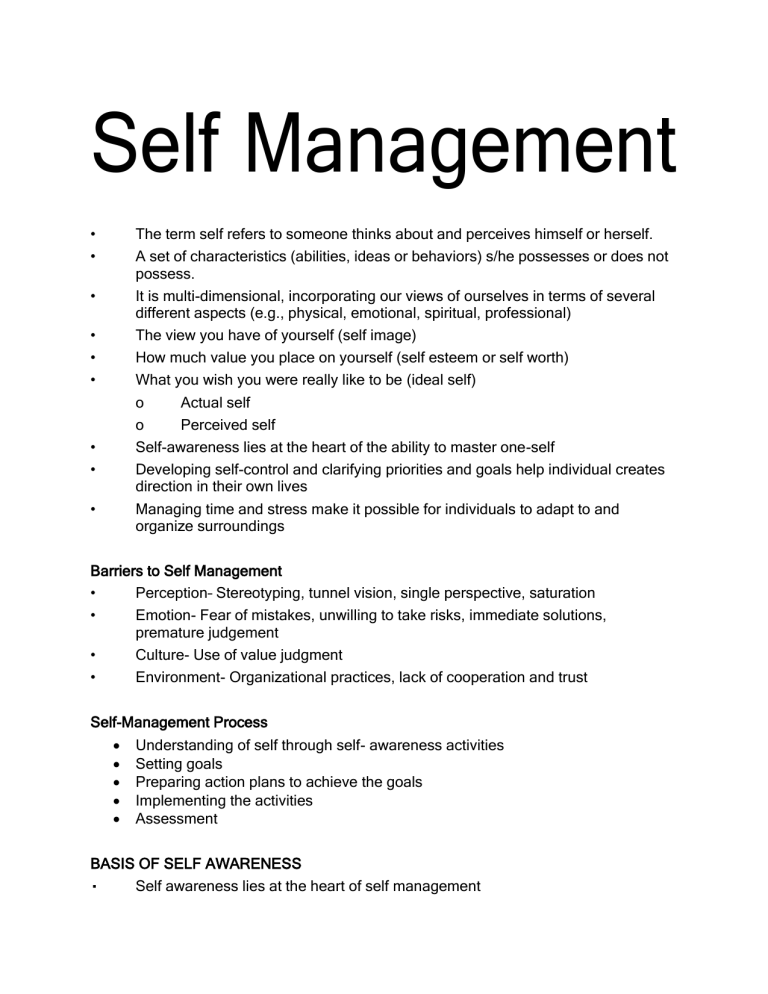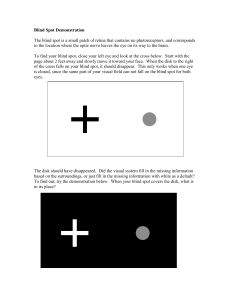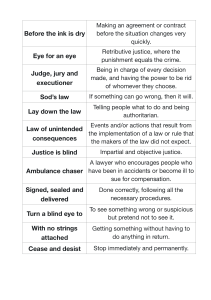Self-Management: Skills, Awareness, Time & Stress Management
advertisement

Self Management • • The term self refers to someone thinks about and perceives himself or herself. A set of characteristics (abilities, ideas or behaviors) s/he possesses or does not possess. It is multi-dimensional, incorporating our views of ourselves in terms of several different aspects (e.g., physical, emotional, spiritual, professional) The view you have of yourself (self image) How much value you place on yourself (self esteem or self worth) What you wish you were really like to be (ideal self) o Actual self o Perceived self Self-awareness lies at the heart of the ability to master one-self Developing self-control and clarifying priorities and goals help individual creates direction in their own lives Managing time and stress make it possible for individuals to adapt to and organize surroundings • • • • • • • Barriers to Self Management • Perception– Stereotyping, tunnel vision, single perspective, saturation • Emotion- Fear of mistakes, unwilling to take risks, immediate solutions, premature judgement • Culture- Use of value judgment • Environment- Organizational practices, lack of cooperation and trust Self-Management Process Understanding of self through self- awareness activities Setting goals Preparing action plans to achieve the goals Implementing the activities Assessment BASIS OF SELF AWARENESS Self awareness lies at the heart of self management o o o o Creating self-awareness: Self analysis Reflection of past events Critical incidents Managing from inside out Unknown to Others Known to Others Hidden Spot Open Window Known to Self Unknown Window Blind Spot Unknown to Self Open Self The open area is that part of an individuals’ conscious self – his/her attitudes, behavior, motivation, values, way of life - of which they are aware and which is known to others. Blind Self There are things about people which they do not know, but that others can see more clearly is the blind self. When others say what they see, in a supportive, responsible way, and people are able to hear it; in that way they are able to test the reality of who they are and are able to grow. Hidden Self • Hidden area of self be known to others unless it is disclosed. • The degree to which we share ourselves with others is the degree to which we can be known. Unknown Self We are more rich and complex than that which we and others know, but from time to time something happens - is felt, read, heard, dreamed - something from our unconscious is revealed. Then we "know" what we have never "known" before. Increasing Self-Awareness Unknown to Others Known to Others Known to Self Open Window Reduce Hidden Area through Disclosure to Others Reduce Blind Spot through Feedback from Others Unknown to Self to get better, because one should know how well s/he is doing. to make the right decisions, by knowing the blind spots. to do great work, learning by past mistakes and address them. Time and Priority Management • Process of organizing and planning how to divide time between specific activities • Failing to manage time damages one’s effectiveness and causes stress Action Priority Matrix Makes easier to make decisions and sets out clearly which activities must be finished on time and which activities can be omitted or performed at a later time. High Major projects Fills in Hard slogs Impact Quick wins Low Low Effort High Quick wins - high Impact low Effort • These activities can be completed routinely without affecting quality and they support the business continuity process. • Focus on these quick wins as much as you can. Major projects - high Impact and a High Effort Gives good return for organization but take a long time to complete. Make sure that major projects do not crowd out the Quick Wins. It is important to pay much attention to these Major Projects, so that the execution of the activities can be mastered well. Working quickly and efficiently can be helpful in this Fill Ins - low Impact and a low Effort • These are low-priority activities that can be dealt with at a later time. • It often stagnate activities with a higher priority. • Perform these tasks when you have got the time to do so. Hard Slogs “thankless tasks” – low Impact but require a high Effort • Avoid Hard Slogs and outsource them to experts. If you do not do this, thankless and energy consuming tasks will yield low returns and there will be too little time for more important business. Self Management through managing time Prioritizing the task • Focus on role and responsibility • Ask yourself, “what is the more important things for me to be doing at this time?” • Analyze and adjust scheduling as needed • Ask yourself – is your schedule is balance (work, family time for self) • Consider if the action is what you want or need to be doing right now; if not, say “No.” Dealing with Stressful Situations Exchange attitude for gratitude Relax (Me Time) Look at the big picture "Life is 10% what happens to us, and 90% how we react to it." taking time to yourself for rejuvenation and relaxation (Yoga, Meditation, Quite time) Set goal (s), performance objectives, and challenging but realistic expectations Develop an action plan, concrete and manageable steps Make a commitment Overcome obstacles, evaluate your own performance Assess the progress




